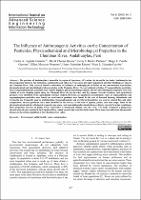Mostrar el registro sencillo del ítem
The influence of anthropogenic activities on the concentration of pesticides, physicochemical and microbiological properties in the Chumbao river, Andahuaylas, Perú
| dc.contributor.author | Ligarda Samanez, Carlos A. | es_PE |
| dc.contributor.author | Choque Quispe, David | es_PE |
| dc.contributor.author | Ramos Pacheco, Betsy S. | es_PE |
| dc.contributor.author | Peralta Guevara, Diego E. | es_PE |
| dc.contributor.author | Moscoso Moscoso, Elibet | es_PE |
| dc.contributor.author | Palomino Rincón, Henry | es_PE |
| dc.contributor.author | Huamán Carrión, Mary L. | es_PE |
| dc.date.accessioned | 2023-03-24T15:12:53Z | |
| dc.date.available | 2023-03-24T15:12:53Z | |
| dc.date.issued | 2021 | |
| dc.identifier.uri | https://hdl.handle.net/20.500.14168/753 | |
| dc.description.abstract | The province of Andahuaylas is located in the region of Apurimac, a Peruvian city located in the Andes. Andahuaylas has three important districts: San Jerónimo, Andahuaylas and Talavera. These areas are highly populated, and their buildings are close to the Chumbao River. This research aimed to determine the influence of anthropogenic activities on the concentration of pesticides, physicochemical and microbiological characteristics in the Chumbao River. Five agricultural activities, 19 organochlorine pesticides, and 25 organophosphorus pesticides were studied. Eighteen physicochemical properties and two microbiological properties were also studied at seven sampling points along the Chumbao River during the rainy and dry seasons. Several veterinary and agricultural products were identified in the agricultural activities studied. However, no significant concentration values of organochlorine and organophosphate pesticides were found; no weed control products were found. In the case of livestock farming, albendazole and ivermectin are frequently used as anthelmintics. Organophosphate and pyrethroid insecticides are used to control flies and other ectoparasites. Several pesticides have been identified in the surveys in the case of quinoa, potato, and corn crops. Some of the physicochemical and microbiological properties are above environmental quality standards according to current Peruvian regulations; these properties increase at points where wastewater is discharged directly into the river. The study evidenced a progressive deterioration of water quality in the Chumbao River caused by anthropic activities in the basin. These may cause infectious and parasitic diseases in the urban population of the Chumbao river valley. | es_PE |
| dc.format | application/pdf | es_PE |
| dc.language.iso | eng | es_PE |
| dc.publisher | International Journal on Advanced Science, Engineering and Information Technology (IJASEIT) | es_PE |
| dc.rights | info:eu-repo/semantics/openAccess | es_PE |
| dc.rights.uri | es_PE | |
| dc.rights.uri | http://creativecommons.org/licenses/by-nc-nd/4.0/ | * |
| dc.subject | Environment; public health; water contamination. | es_PE |
| dc.title | The influence of anthropogenic activities on the concentration of pesticides, physicochemical and microbiological properties in the Chumbao river, Andahuaylas, Perú | es_PE |
| dc.type | info:eu-repo/semantics/article | es_PE |
| dc.type.version | info:eu-repo/semantics/publishedVersion | es_PE |
| dc.publisher.country | ID | es_PE |
| dc.subject.ocde | http://purl.org/pe-repo/ocde/ford#1.05.11 | es_PE |


